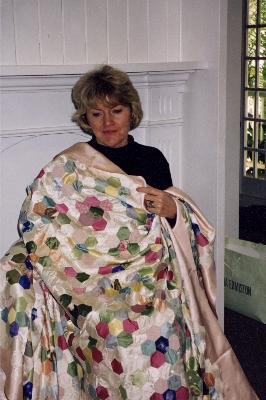Quilt No.369PH - Pauline Hunter

2211 x 1752mm
Made in the late 1950s or early 1960s by Shiela Hungerford (born Wilson) 1913 - 1974. Shiela married Harold Hungerford in the late 1930s and they moved to Goondawindi (Qld) where Harold managed a large cattle station. They later bought 'Farleigh Downs'. The quilt was only brought out for special occasions. Owned by her daughter Penny Dowling (born Hungerford).
"My mother was brought up by rather elderly parents and in many ways was very conservative but in other ways was a pioneer of women's interests in Queensland's South West during the 50s and 60s. �. She was born at Katoomba in the Blue Mountains. Her mother had spent 13 years attending boarding schools and decided that this would not happen to her daughter so Shiela was tutored privately at her home near Crookwell NSW. As a result I think my mother grew up in a most unique atmosphere, and that shaped her nature. She became a remarkable character.
My parents were married in NSW in the late 30s and moved to QLD where my father was overseer of a large cattle station. Living conditions were fairly spartan. Having lived such a protected life I wonder how my mother coped and then had so much to give to her fellow country women.
They soon purchased their own property, thousands of acres of undeveloped scrub, with plenty of dingoes! Communication was difficult. Phone lines easily broken by falling trees and roads of black soil impassable with a shower of rain. Yet my mother had a passion to communicate with all people in the area, especially women, by church gatherings or huge Christmas parties with Santa. As there were no local schools, children received lessons through Primary Correspondence. Home entertaining was often the only outing for people, as my parents enjoyed company, we had lots of large and small 'occasions' in the great garden that my mother established.
My Mother helped form the Country Women's Assn in the area, and was totally involved for 30 years, holding many executive positions. As roads and phones improved she travelled further and further field. She developed a keen interest in anything that could be made by hand. She had a talent for involving people in her creative ideas. Women who had never dreamed that they could make anything would discover that they could make a paper flower or spin the wool that they grew. This gave them great satisfaction and an interest other than the solely rural pursuit of their husbands This pleasure was the greatest spur for my mother. The list of 'crafts' that my mother could teach was almost endless, and a lot of the raw material she bought herself and shared with women all over the South-West. Anyone who ever met my mother remembers her, for her charm, generosity and her graciousness. She bought a lot of happiness to lonely women in isolated areas, and often showed them how to be resourceful and cope with the harshness that must have been prevalent at that time in Queensland. My father was also public spirited and was very involved in Local Government and later a State Member of Government.
As far as I know my mother was never taught these many 'Handicrafts', she simply had a great determination and memory. She would walk past a shop window in Queen St. and then go home and make the dress and hat that the model was wearing!
It was a wonderful life very busy and creative, but in the late 60s and early 70s it all ended. Firstly her eldest daughter was killed in a car accident, then her husband died of Motor Neurone disease. � My mother was devastated by these cruel blows and threw herself totally in serving the C.W.A. Now she became very interested in gaining some really superior creative skills, and attended one of the first McGregor Summer Schools in Toowoomba. She was killed in a car accident on the way home. She was only 58.
All this was 24 years ago. There are still many people whose lives she touched, they will retell numerous tales about her acts of kindness. Many still hold proudly in their possession something that she gave them or
made specially for them."
[Penny Dowling Toowoomba 8.3.1998]

Related Quilts:
1770 x 1740mm
2100 x 1800mm
1931 x 1728mm
2280 x 1520mm
1550 x 1420mm






